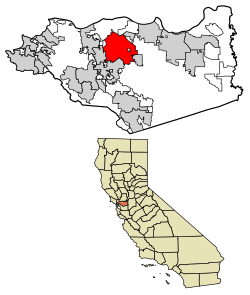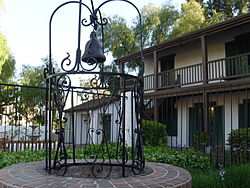Concord, California
Concord is the largest city in Contra Costa County, California, US. In the 2020 census, 125,410 people lived there.[5] Concord was founded in 1869. It was named Todos Santos at first, but the name was soon changed to Concord. The city is 31 miles (50 km) east of San Francisco.
|
Todos Santos “La Purunga” | |
|---|---|
 | |
 Location of Concord in Contra Costa County | |
| Coordinates: 37°58′41″N 122°01′52″W / 37.97806°N 122.03111°WCoordinates: 37°58′41″N 122°01′52″W / 37.97806°N 122.03111°W | |
| Country | United States |
| State | California |
| County | Contra Costa |
| Incorporated | February 8, 1905[1] |
| Government | |
| • Type | City Council/City Manager[2] |
| Area | |
| • Total | 30.55 sq mi (79.13 km2) |
| • Land | 30.55 sq mi (79.13 km2) |
| • Water | 0.00 sq mi (0.00 km2) |
| Elevation | 75 ft (23 m) |
| Population | |
| • Total | 125,410 |
| • Rank | |
| • Density | 4,104.67/sq mi (1,584.85/km2) |
| Time zone | UTC−8 (Pacific) |
| • Summer (DST) | UTC−7 (PDT) |
| ZIP Codes | 94518–94521 |
| FIPS code | 06-16000 |
| GNIS feature IDs | 1658308, 2410214 |
| Website | Lua error in Module:Official_website at line 90: attempt to index field 'wikibase' (a nil value). |
Geography
Concord is at 37°58′41″N 122°01′52″W / 37.97806°N 122.03111°W.[6] It is 29 miles (47 km) northeast of San Francisco, 22 miles (35 km) northeast of Oakland, 65 miles (105 km) southwest of Sacramento, and 51 miles (82 km) north of San Jose.[7]
According to the United States Census Bureau, the city has a total area of 30.5 square miles (79 km2). All of it is land.
The center of downtown Concord is Todos Santos Plaza. The plaza takes up an entire city block. It is known for its farmers market, free summer concerts, and many restaurants. There are new apartments and condominiums near the plaza.
History
Concord was first named Todos Santos. In the 19th century, most people in Pacheco moved to Concord to get away from fires and floods. Concord became a city on February 5, 1905.
The area around Concord in the Ygnacio and Clayton Valleys was a big farming area. To the east, where the Concord Naval Weapons Station was later built, there were big wheat ranches over 5,000 acres (20 km2). They covered the land all the way to the marshes by Suisun Bay. During Prohibition, many vineyards were removed and replaced with walnut trees.
The first Concord post office opened in 1872.
Port Chicago disaster
On July 17, 1944, the weapons on a United States Navy ship exploded. This caused the highest number of deaths at a time among African Americans during World War II. The explosion killed 320 people. The explosion was felt 30 miles away. Later, 258 African American sailors refused to load any more weapons. That was the start of the Navy's biggest-ever mutiny trial. In that trial, 50 men were found guilty. Future Supreme Court Justice Thurgood Marshall was at the trial. He said that he saw a prejudiced court.[8]
Sunvalley Mall plane crash
On December 23, 1985, a small airplane crashed into the roof of Sunvalley Mall. The pilot and two people on the plane were killed. 84 people in the mall were hurt, mostly from burning fuel. Four of the people in the mall later died from their injuries. The accident made more people be against the local airport. Pacific Southwest Airlines delayed starting passenger service there that had been planned for the new year.
North of the city of Concord is the Concord Naval Weapons Station. It was opened in 1942. During World War II, weapons were kept there. The weapons were for warships at Port Chicago. The Concord NWS helped war efforts during the Vietnam War and through the end of the Gulf War, taking care of equipment and supplies.[9]
The station has two main areas. One is the Inland Area, 5,170 acres (21 km2), which is inside the Concord city limits. The other is the Tidal Area, 7,630 acres (31 km2).[10] Because of changes in military operations, parts of the Inland Area stopped being used. By 1999, the station had only a few military people working there. In 2007 the United States government decided to close the inland part of the station. The Tidal area of the base stayed open.[9] The city of Concord is working on a plan for how to use the land. Their plans will have to be approved by the Navy.[10][11]+{{{1}}}−{{{2}}}
Transportation
Until 1995 the city was the eastern end of the Concord line of Bay Area Rapid Transit (BART) commuter train system. Since then, more track was built. BART now goes farther than Concord. Bus service runs in the city and other points in the county.
Interstate 680 goes through Concord. So do state highways 4 and 242.
Buchanan Field Airport is a public county-owned airport in the City of Concord. It currently does not have any scheduled passenger service. It was once served by WestAir, Pacific Southwest Airlines, and later U.S. Airways for a short time. In 1977, Buchanan Field reached its peak of activity with 357,000 total operations making it the 16th busiest airport in the nation that year.
Education
Concord has several public high schools:[12]
- Clayton Valley High School, opened in 1958
- Concord High School, opened in 1966
- Mt. Diablo High School, opened in 1905
- Ygnacio Valley High School, opened in 1960
There are also two private Catholic high schools:
- De La Salle High School,[13] for boys. De La Salle's football team set a record by winning 151 games in a row between 1992 and 2004.
- Carondelet High School,[14] for girls
California State University, East Bay has a campus in Concord.
Arts and culture
The Concord Jazz Festival is held every year..
Concord is also home to the 14-time World Champion Blue Devils Drum and Bugle Corps. The corps is made up of talented musicians from around the world. The Concord Blue Devils are the most decorated drum and bugle corps in the history of Drum Corps International.
Points of interest
- Sleep Train Pavilion - a major concert venue formerly known as the Concord Pavilion, and also as Chronicle Pavilion at Concord.
- Sunvalley Mall
- Farmer's Market concerts and movies at Todos Santos Plaza
- Buchanan Field Airport
- Camp Concord,[15] at South Lake Tahoe, a family-oriented Summer Camp, although not located in Concord, is operated by the city.
- Port Chicago Naval Magazine National Memorial[16]
- Six Flags Waterworld Concord
- Starting Point of the Iron Horse Regional Trail
Sister city
In 1974 Concord became a sister city with Kitakami, Iwate, in Japan. The city built a small park in the city, and put half of a sculpture, The Communion Bridge, in it. The other half of the bridge is in Kitakami.[17]
Concord, California Media
Concord was founded as "Todos Santos" in 1869 by Don Salvio Pacheco, a noted Californio ranchero.
The Pacheco Adobe, built 1835 on Rancho Monte del Diablo
Artwork produced by Japanese and American citizens to celebrate the sister city relationship between Concord and Kitakami, located at the civic center
References
- ↑ "California Cities by Incorporation Date". California Association of Local Agency Formation Commissions. Archived from the original (Word) on November 3, 2014. Retrieved March 27, 2013.
- ↑ "City Government Overview". Concord CA. Archived from the original on July 22, 2015. Retrieved March 13, 2015.
- ↑ "2020 U.S. Gazetteer Files". United States Census Bureau. Archived from the original on March 18, 2021. Retrieved October 30, 2021.
- ↑ "Concord". Geographic Names Information System. United States Geological Survey. Retrieved December 4, 2014.
- ↑ 5.0 5.1 "QuickFacts: Concord city, California". U.S. Census Bureau. Retrieved July 31, 2023.
- ↑ U.S. Geological Survey Geographic Names Information System: Concord, California
- ↑ City of Concord City Profile, official city web site, retrieved on 2007-08-16 Archived 2007-11-04 at the Wayback Machine
- ↑ Allen, Robert L. (2006). The Port Chicago Mutiny. Berkeley, CA: Heyday Books. p. 118. ISBN 978-1-59714-028-7. OCLC 63179024.
- ↑ 9.0 9.1 Concord Naval Weapons Station Reuse Information Portal. Retrieved 2007-08-13. Archived 2011-07-25 at the Wayback Machine
- ↑ 10.0 10.1 About the City of Concord Community Reuse Project Archived 2007-10-09 at the Wayback Machine, official city web site'. Retrieved 2007-08-13.
- ↑ "Concord Naval Weapons Station". Contra Costa Times website collection of articles. Retrieved 2007-08-13.
- ↑ "Mt. Diablo USD Schools". Archived from the original on 2012-08-04. Retrieved 2012-01-10.
- ↑ "De La Salle High School: Home". Archived from the original on 2011-12-15. Retrieved 2012-01-10.
- ↑ Carondelet High School: Home
- ↑ Official Camp Concord homepage
- ↑ Largest homeland disaster during World War II from the National Park Service
- ↑ City of Concord Sister City Archived 2008-09-21 at the Wayback Machine, official city web site, retrieved on 2007-08-16
Other websites
| Wikimedia Commons has media related to Lua error in Module:Commons_link at line 62: attempt to index field 'wikibase' (a nil value).. |
| Wikivoyage has a travel guide about: Concord (California) |







